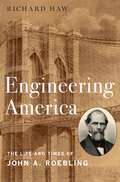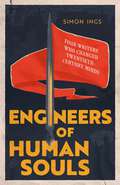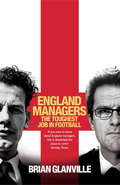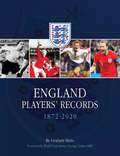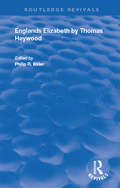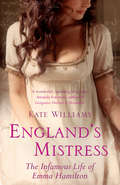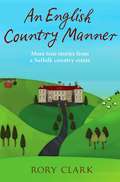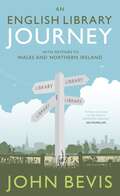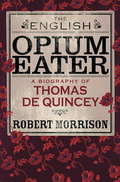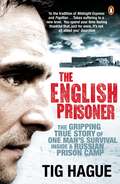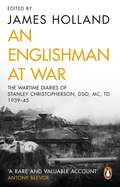- Table View
- List View
Engineering America: The Life and Times of John A. Roebling
by Richard HawJohn Roebling was one of the nineteenth century's most brilliant engineers, ingenious inventors, successful manufacturers, and fascinating personalities. Raised in a German backwater amid the war-torn chaos of the Napoleonic Wars, he immigrated to the US in 1831, where he became wealthy and acclaimed, eventually receiving a carte-blanche contract to build one of the nineteenth century's most stupendous and daring works of engineering: a gigantic suspension bridge to span the East River between New York and Brooklyn. In between, he thought, wrote, and worked tirelessly. He dug canals and surveyed railroads; he planned communities and founded new industries. Horace Greeley called him "a model immigrant"; generations later, F. Scott Fitzgerald worked on a script for the movie version of his life. Like his finest creations, Roebling was held together by the delicate balance of countervailing forces. On the surface, his life was exemplary and his accomplishments legion. As an immigrant and employer, he was respected throughout the world. As an engineer, his works profoundly altered the physical landscape of America. He was a voracious reader, a fervent abolitionist, and an engaged social commentator. His understanding of the natural world, however, bordered on the occult and his opinions about medicine are best described as medieval. For a man of science and great self-certainty, he was also remarkably quick to seize on a whole host of fads and foolish trends. Yet Roebling held these strands together. Throughout his life, he believed in the moral application of science and technology, that bridges--along with other great works of connection, the Atlantic Cable, the Transcontinental Railroad--could help bring people together, erase divisions, and heal wounds. Like Walt Whitman, Roebling was deeply committed to the creation of a more perfect union, forged from the raw materials of the continent. John Roebling was a complex, deeply divided yet undoubtedly influential figure, and this biography illuminates not only his works but also the world of nineteenth-century America. Roebling's engineering feats are well known, but the man himself is not; for alongside the drama of large scale construction lies an equally rich drama of intellectual and social development and crisis, one that mirrored and reflected the great forces, trials, and failures of nineteenth century America.
Engineers of Human Souls: Four Writers Who Changed Twentieth-Century Minds
by Simon IngsFour writers. Four dictators. One world, changed out of all recognition. ENGINEERS OF HUMAN SOULS is an intimate and shocking shadow history of creative vanity in a time that turned writers - once the faithful servants of authority - into figures of political consequence.Maurice Barrès, who first wielded the politics of identity. Gabriele D'Annunzio, whose poetry became a blueprint for fascism. Maxim Gorky, dramatist of the working class and Stalin's cheerleader. The Maoist Ding Ling, whose stories exculpated the regime that kept her imprisoned.All four nursed extravagant visions of the future, and believed they were vital to its realisation. Each was lured to the centre of political action. Each established a dangerous and damaging relationship with a notorious dictator. And when writers and rulers find a use for each other, the consequences can be shattering for us all. These stories - of courage and compromise, vanity and malevolence - speak urgently to the uncontrollable power of words.
England Managers: The Toughest Job In Football
by Brian GlanvilleThe England national team has had 12 full-time managers and Brian Glanville has known them all. In this fascinating account of each man his strengths, weaknesses and impact on the game Brian Glanville provides an in-depth analysis of the team as well as the individuals under scrutiny. Funny, controversial, measured and thought-provoking, Glanvilles assessment of why England has underachieved is required reading for all football fans and for every member of the FA Committee if they are prepared to confront some unpalatable truths.On Revie: He was never cut out for the lonely exposed life of an international manager almost pathologically thin-skinned.On Robson: A mixture of good and bad luck characterised his years. He never seemed fully in control.On Venables: Highly competent but appointed a few years too late.On Hoddle: A curates egg of a regime.'
England Players' Records: 1872 - 2020
by Graham BettsIt has been some ten years since the first edition of England Players’ Records was published, during which time more than 100 players have been capped for the national side on at least one occasion. During that same time frame, no fewer than five players have joined the exalted ranks of centurions by winning their one hundredth cap. Now comprehensively updated, the book contains details of each and every footballer who has played for England, 1235 in total, including all the squad players who took part in the FIFA World Cup in Russia under new manager Gareth Southgate. Compiled by Graham Betts, the leading expert on England’s football team, the Players’ Records includes a foreword by World Cup winning full-back George Cohen who celebrated his 80th birthday in October 2019.
England Rule (Football Superstars #5)
by Simon MugfordIs England the team you cheer for at every EUROs or World Cup? Currently ranked among the top ten, the team has featured in no less than 16 World Cup finals, winning it in 1966, and then came so close to lifting the European trophy in 2020!In this fun and fact-filled book about the England's men's team, Football Superstar's dynamic duo, Dan and Simon, will take you through the historic highs of the 1966 World Cup, the heartbreak and tears of 1990 and 1996 to the resurgence of the current team. Along the way you'll learn about the legendary players, managers, matches, songs, fans and, of course, all the stats that tell the story of England's national sporting obsession.Football Superstars is a series aimed at building a love of reading from a young age, with fun cartoons, inspirational stories, a simple narrative style and a cast of characters chipping in with quotes, jokes and comments.
Englands Elizabeth (Routledge Revivals)
by Thomas HeywoodPublished in 1982: England’s Elizabeth was first issues in 1631, and it is probably the earliest separately published biography of Elizabeth I’s early years. An important example of the author’s considerable, and largely neglected, non-dramatic work, the book has never been previously edited.
Englands Elizabeth (Routledge Revivals)
by Thomas HeywoodPublished in 1982: England’s Elizabeth was first issues in 1631, and it is probably the earliest separately published biography of Elizabeth I’s early years. An important example of the author’s considerable, and largely neglected, non-dramatic work, the book has never been previously edited.
England's Mistress: The Infamous Life of Emma Hamilton
by Kate WilliamsA dramatic, sparkling tale of sex, glamour, intrigue, romance and heartbreak, England's Mistress traces the rise and rise of the gorgeous Emma Hamilton.Born into poverty, she clawed her way up through London's underworlds of sex for sale to become England's first media superstar. Nothing could stand in the way of her dreams- except her self-destructive desires. Drawing on hundreds of previously undiscovered letters, and told with a novelist's flair, England's Mistress captures the relentless drive, innovative style and burning passion of a true heroine. In a world of tabloid fame and three-minute wonders, Emma's life is truly a tale for our time.
English Country House Eccentrics: The Eccentric Lives Of The English Aristocracy
by David LongThis is a lighthearted, witty but factual biographical account of the eccentric lifestyles of the builders and residents of one hundred of England’s best-known country houses. Extraordinary buildings require extraordinary people, and over the centuries our historic houses have produced more than their fair share of oddballs. Insulated from the outside world by vast wealth, rolling acres and the social status that a title implies, aristocrats have always been able to amuse themselves - and now us - by pursuing idiosyncratic interests and manias to the point of eccentricity. The 12th Duke of Bedford, for example, preferred parrots to people - forcing his children to steal the birds’ food to make up their meagre rations – while the 5th Duke of Portland paid his staff a bonus on the understanding they would never speak to him. The Hon. Henry Cavendish inherited £200 million at today’s values, but never spent more than five shillings on dinner, while more recently the 2nd Lord Rothschild spent weeks training a team of zebra to pull his carriage up the Mall and into Buckingham Palace. Aimed squarely at the National Trust set, this lifts the lid on all that’s bizarre, implausible, unthinkable and downright wacky about our glorious heritage homes and their unusual occupants.
An English Country Manner: More true stories from a Suffolk country estate
by Rory ClarkJames Aden has his hands full when he leaves the comparative sanity of a job on an estate in Scotland when his wife inherits a farm in Suffolk. To supplement the income from the farm, he takes a job as an agent on Sir Charles Buckley's vast estate. The list of problems, and problematic characters, that he has to deal with is virtually endless with rogue chimney pots, unsavoury tenants and delinquent sheep giving him frought days and sleepless nights. There's no point in counting sheep to get to sleep when they simply won't do as they're told. Then there's the farm secretary, Gail, whose turbulent love life provides James with even more headaches than the troublesome sheep, without even the prospect of a decent Sunday roast to look forward to once the troublemakers have been put out of their misery!
The English Dane: From King of Iceland to Tasmanian Convict
by Sarah BakewellThis gripping nineteenth-century adventure stars Jorgen Jorgenson, who ran away to sea at fourteen and began a brilliant career by sailing to establish the first colony in Tasmania. Twists of fortune then found him captaining a warship for Napoleon before joining a British trading voyage to Iceland, where he staged an outrageous coup and ruled the country for two months.Much lay ahead, from imprisonment in the hulks to patronage by Joseph Banks and travels in Europe as a British spy. But Jorgenson was dogged by his own excesses, and ended up transported as a convict to the very colony he helped to found. Here he reinvented himself again as an explorer, and, despite his sympathy for the people, was caught up in the terrible Aboriginal clearances. Using unpublished sources and letters, Sarah Bakewell tells his astonishing tale with dazzling verve.
English Food: A People's History
by Diane Purkiss‘An absolute gem’ Sunday Times ‘A mouthwatering history’ The Guardian
An English Library Journey: With Detours to Wales and Northern Ireland
by John BevisJohn Bevis is a writer and book-lover on an eccentric quest: to obtain a membership card from every library authority in England. In a ten-year mission criss-crossing the country - from Solihull to Slough, from Cleveland to Cornwall - he enrols at libraries of all shapes and sizes: monuments to Art Deco or Brutalism; a converted corset factory; one even shaped like a pork pie. With the architectural eye of Pevsner and the eavesdropping ear of Bill Bryson, he engages us at every step with anecdotes and apercus about the role of the public library in our national life, while ruing its decline in the age of austerity. As interested in the people he finds as he is in the buildings and their history, he is a humane, witty and erudite guide. The result is a book to be treasured by anyone who has ever used a library.
The English Opium-Eater: A Biography of Thomas De Quincey
by Robert MorrisonDefinitive life of the author of CONFESSIONS OF AN ENGLISH OPIUM-EATER, journalist, political commentator and biographer.Thomas De Quincey's friendships with leading poets and men of letters in the Romantic and Victorian periods - including William Wordsworth, Samuel Taylor Coleridge and Thomas Carlyle - have long placed him at the centre of 19th-century literary studies. De Quincey also stands at the meeting point in the culture wars between Edinburgh and London; between high art and popular taste; and between the devotees of the Romantic imagination and those of hack journalism. His writing was a tremendous influence on Edgar Allan Poe, Charles Dickens, William Burroughs and Peter Ackroyd.De Quincey is a fascinating (and topical) figure for other reasons too: a self-mythologizing autobiographer whose attitudes to drug-induced creativity and addiction strike highly resonant chords for a contemporary readership. Robert Morrison's biography passionately argues for the critical importance and enduring value of this neglected essayist, critic and biographer.
The English Prisoner: The Gripping True Story Of One Man's Survival Inside A Russian Prison Camp
by Tig HagueIn July 2003 young Englishman Tig Hague was on a routine business trip to Moscow when he was arrested at the airport. Within hours he was accused of a major crime. Next, he was tried and transported hundreds of miles to the remote, forsaken wastes of Mordovia.And prison camp Zone 22.Sentenced to spend the next four years there, every day was a struggle against disease, freezing temperatures, malnutrition, the unpredictable, sometimes terrifying behaviour of the camp guards and his fellow prisoners.But, most of all, it was a fight to ensure his own psychological survival.Only the thought of his girlfriend Lucy, fighting Russia's corrupt and labyrinthine legal system, kept Tig sane - and gave him a reason to see each day to its end.The English Prisoner is an extraordinary story of endurance, as one man - plucked from his normal, everyday life - is forced to reach deep inside himself to survive life in one of the bleakest outposts in the world: Russia's vast and unforgiving 'forgotten zone'.
An English Psychic in Hollywood
by Lucinda ClareSparklingly original and hugely entertaining, An English Psychic in Hollywood is the magical tale of Lucinda Clare's personal experiences as an actress and psychic among the stars of Hollywood. A cross between Jackie Collins and Bridget Jones, there is glitz and glamour mixed with dating dilemas and wardrobe malfunctions. Originally coming to LA to land her dream acting job, Lucinda soon discovers that it is her psychic abilities that make her stand out amongst the wannabe actresses. As soon as she says the magic words, 'I'm psychic!' everyone wants to talk to her, from publicists to agents, A-list film stars to borderline psychotics.Accompanied by new best friend crazy Astrid, she gradually settles in. She talks Hindu with her hairdresser, does readings for everyone from screenwriters to sex slaves and finds herself falling for the archetypal tall, dark, handsome stranger. But is he the soulmate that is meant to be in her future? Only time, some crazy pool parties and successfully predicting everyone else's happy endings will tell...
English Siege and Prison Writings: From the ‘Black Hole’ to the ‘Mutiny’
by Pramod K. NayarThis volume brings together an unusual collection of British captivity writings – composed during and after imprisonment and in conditions of siege. Writings from the ‘Mutiny’ of 1857 are well known, but there exists a vast body of texts, from Afghanistan, Sri Lanka and Burma, and the Indian subcontinent, that have rarely been compiled or examined. Written in anxiety and distress, or recalled with poignancy and anger, these siege narratives depict a very different Briton. A far cry from the triumphant conqueror, explorer or ruler, these texts give us the vulnerable, injured and frightened Englishman and woman who seek, in the most adverse of conditions, to retain a measure of stoicism and identity. From Robert Knox’s 17th-century account of imprisonment in Sri Lanka, through J. Z. Holwell’s famous account of the ‘Black Hole’ of Calcutta, through Florentia Sale’s Afghan memoir, and Lady Inglis’s ‘Mutiny’ diary from Lucknow, the book opens up a dark and revealing corner of the colonial archive. Lucid and intriguing, this book will be of great interest to scholars and researchers of modern South Asia, colonial history, literary and culture studies.
English Siege and Prison Writings: From the ‘Black Hole’ to the ‘Mutiny’
by Pramod K. NayarThis volume brings together an unusual collection of British captivity writings – composed during and after imprisonment and in conditions of siege. Writings from the ‘Mutiny’ of 1857 are well known, but there exists a vast body of texts, from Afghanistan, Sri Lanka and Burma, and the Indian subcontinent, that have rarely been compiled or examined. Written in anxiety and distress, or recalled with poignancy and anger, these siege narratives depict a very different Briton. A far cry from the triumphant conqueror, explorer or ruler, these texts give us the vulnerable, injured and frightened Englishman and woman who seek, in the most adverse of conditions, to retain a measure of stoicism and identity. From Robert Knox’s 17th-century account of imprisonment in Sri Lanka, through J. Z. Holwell’s famous account of the ‘Black Hole’ of Calcutta, through Florentia Sale’s Afghan memoir, and Lady Inglis’s ‘Mutiny’ diary from Lucknow, the book opens up a dark and revealing corner of the colonial archive. Lucid and intriguing, this book will be of great interest to scholars and researchers of modern South Asia, colonial history, literary and culture studies.
An Englishman at War: The Wartime Diaries Of Stanley Christopherson Dso, Mc, Td, 1939-1945
by James Holland Stanley ChristophersonFrom the outbreak of war in September 1939 all the way to the smouldering ruins of Berlin in 1945, via Palestine, Tobruk, El Alamein, D-Day, Nijmegen and the crossing of the Rhine, An Englishman at War is a unique first-person account of the Second World War.The Sherwood Rangers Yeomanry, Stanley Christopher’s regiment, went to war as amateurs, equipped with courage but very little else, and ended up one of the most experienced, highly trained and most valued armoured units in the British Army. Their journey through the war, learning through mistakes and tragedy as well as from a determined desire to improve, can, in many ways, be seen to reflect the experience of the British Army as a whole. From Alamein onwards, the Sherwood Rangers were in the vanguard of almost every action in which they took part, and over the course of the conflict, they amassed an astonishing thirty battle honours. Christopherson himself was to rise from a junior subaltern to become the commanding officer of the regiment soon after the D-Day landings. He took part in all thirty battle honours, and collected a Distinguished Service Order, two Military Crosses and an American Silver Star, as well as being Mentioned in Despatches four times. His is an extraordinary story.
Enid: The Scandalous High-society Life of the Formidable 'Lady Killmore'
by Robert WainwrightEnid Lindeman stood almost six feet tall, with silver hair and flashing turquoise eyes. She stopped traffic in Manhattan, silenced gamblers in Monte Carlo and walked her pet cheetah through Hyde Park on a diamond collar. In early twentieth century society, where women were expected to be demure and obedient, Enid Lindeman gallivanted through life accumulating four husbands and numerous lovers, her high-jinks dominating British gossip columns during the inter-war years. She drove an ambulance in World War I and hid escaped Allied airmen behind enemy lines in World War II, played bridge with Somerset Maugham and entertained Hollywood royalty in the world's most expensive private home on the Riviera, allegedly won in a game of cards. Enid bedazzled men with her beauty, outlived four husbands-two shipping magnates, a war hero and a larger-than-life Irish Earl-spent two great fortunes and earned the nickname 'Lady Killmore'. From Sydney to New York, London to Paris and Cairo to Kenya, Robert Wainwright's biography restores the remarkable Enid to thrilling, vivid life.
Enid Blyton: The Biography (Sutton Ser.)
by Barbara StoneyEnid Blyton is known throughout the world for her imaginative children's books and her enduring characters such as Noddy and the Famous Five. She is one of the most borrowed authors from British libraries and still holds a fascination for readers old and young alike. Yet until 1974, when Barbara Stoney first published her official biography, little was known about this most private author, even by members of her own family.The woman who emerged from Barbara Stoney's remarkable research was hardworking, complex, often difficult and, in many ways, childlike. Now this widely praised classic biography has been fully updated for the twenty-first century and, with the addition of new colour illustrations and a comprehensive list of Enid Blyton's writings, documents the growing appeal of this extraordinary woman throughout the world. The fascinating story of one of the world's most famous authors will intrigue and delight all those with an interest in her timeless books.
Enigma A New Life of Charles Stewart Parnell: A New Life Of Charles Stewart Parnell
by Paul BewCharles Stewart Parnell is the most enigmatic figure in Irish history. An Anglo-Irish landlord from a distinguished Wicklow family, he became the most unlikely leader of Irish nationalism imaginable.He hated the colour green. He was not a dynamic speaker. He was cold and aloof and lacked the popular touch. None the less, from the late 1870s until his fall and death in 1891, he held the whole of Ireland spellbound.He established Home Rule for Ireland – previously a taboo subject in British politics – at the centre of Westminster affairs and effectively created the modern Irish state in embryo.His fall was as dramatic as his rise. The affair with Mrs Katharine O'Shea, the mother of his three children, destroyed him. Ever since his fall and his premature death in 1891, Parnell has remained a remarkably potent symbol, particularly in times of crisis and conflict in Ireland. The myth has obscured the man and makes it difficult for us to see Parnell as he really was. Paul Bew presents a completely original interpretation of this fascinating and enigmatic man.
The Enigma of Arrival: A Novel in Five Sections (Picador Classic #101)
by Sir V. S. NaipaulTaking its title from the strangely frozen picture by the surrealist painter Giorgio de Chirico, The Enigma of Arrival tells the story of a young Indian from the Caribbean arriving in post-imperial England and consciously, over many years, finding himself as a writer. It is the story of a journey, from one place to another, from the British colony of Trinidad to the ancient countryside of England, and from one state of mind to another, and is perhaps V. S. Naipaul’s most autobiographical work. Yet alongside this he weaves a rich and complex web of invention and observation. Finding depth and pathos in the smallest moments – the death of a cottager, the firing of an estate’s gardener – Naipaul also comprehends the bigger picture – watching as the old world is lost to the gradual but permanent changes wrought on the English landscape by the march of ‘progress’. ‘Written with the expected beauty of style . . . Instead of diminishing life, Naipaul ennobles it’ Anthony Burgess, Observer
The Enigma of Arrival: A Novel in Five Sections (Picador Classic)
by Sir V. S. NaipaulWith an introduction by Harvard professor and author Maya Jasanoff.Taking its title from a work by the surrealist painter, Giorgio de Chirico, The Enigma of Arrival tells the story of a young Indian from the Caribbean arriving in post-imperial England and consciously, over many years, finding himself as a writer. It is the story of a journey, from one place to another, from the British colony of Trinidad to the ancient countryside of England, and from one state of mind to another, and is perhaps V. S. Naipaul’s most autobiographical work.Finding depth and pathos in the smallest moments Naipaul also comprehends the bigger picture – watching as the old world is lost to the gradual but permanent changes wrought on the English landscape. It is a moving and beautiful novel told with great dignity, compassion, and candour.
The Enigma of Kidson: The Portrait of an Eton Schoolmaster
by Jamie BlackettThe Enigma of Kidson is a scintillating and often hilarious biography of an inspirational and controversial history master, Michael Kidson, who taught a generation of pupils at Eton for forty years. Forget Eton, think Mr Chips, The History Boys and Dead Poets Society. Kidson was a maverick; funny, eccentric, breathtakingly rude, quick-tempered, insulting, kind, compassionate and loyal, with a secret past about which he never spoke. Among his pupils were David Cameron, Matthew Pinsent, Justin Welby, Dominic West, and ‘Lupin’, Johnnie Boden, Nat Rothschild and many others, who all tell stories and anecdotes about how he changed their lives. This biography unravels his complex character and discovers that it has been formed by an early life that is stranger than fiction.
